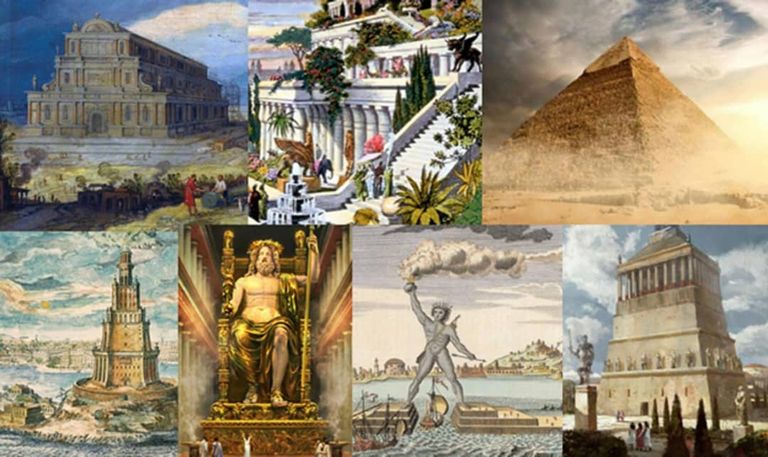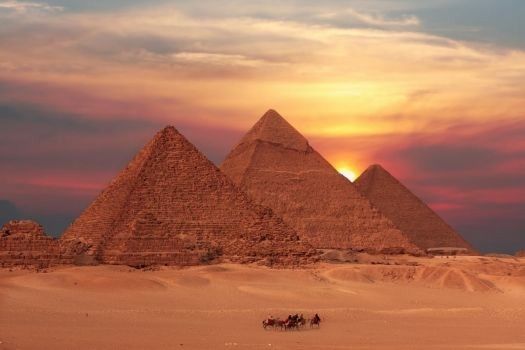
Fuente
Título: Manifestaciones del ingenio humano: Las siete maravillas del mundo antiguo. (Primera Parte) Por Florencia Renata.
El eterno deseo del ser humano de trascender en el tiempo y ser recordado, aún en épocas inimaginables, le han impulsado a crear opciones, superar obstáculos y retarse a sí mismo junto a sus semejantes. La historia nos ha demostrado que la búsqueda incesante de "ser-recordado-por-siempre" logró su propósito cada vez que fue intentado de manera monumental o ingeniosa.
Podemos encontrar muestra de ello en las llamadas Siete Maravillas del Mundo Antiguo. Construcciones y edificaciones que continúan sorprendiéndonos, ya que sin duda, para su momento histórico representaron un reto al ingenio y desarrollo de las capacidades humanas.
Hacia las postrimerías del siglo III antes de nuestra era, apareció una lista en un epigrama del poeta Antípater de Sidón, donde indicaba un grupo de obras extraordinarias realizadas por el ser humano, catalogándolas como "maravillas del mundo" antiguo; sin embargo existe quienes le atribuyen la creación de esta lista al ilustrado ingeniero Filón de Bizancio en el año 150 a.C. De lo que realmente se tiene certeza es que ambas listas coinciden en la selección de las llamadas maravillas:
- ¤Pirámides de Gizeh, Egipto
- ¤Jardines colgantes de Babilonia, actual Irak.
- ¤Estatua de Zeus, Olimpia, Grecia.
- ¤Templo de Artemisa, Efeso, actual Turquía.
- ¤Mausoleo de Halicarnaso, actual Turquía.
- ¤Coloso de Rodas, Isla de Rodas, Grecia.
- ¤Faro de Alejandría, Isla de Faros, Grecia.
Cada una de estas obras contaron con características únicas e innovadoras para su época

Fuente
Pirámides de Gizeh, Egipto.
Fueron construidas con el propósito de ser tumbas de los grandes faraones; es la única de las maravillas que subsisten todavía como muestra de trabajo de cientos de miles de esclavos y del ingenio de los constructores de su tiempo histórico. Datan del año 2650 a.C. Se trataron de tres magníficas pirámides que fueron construidas en la orilla occidental del Nilo, por los monarcas de la IV dinastía: Keops, Kefrén y Mikerinos. Se dice que las piedras fueron llevados desde Libia y que dicha tarea demandó diez años.
La manera en la que se edificaron estos notables monumentos es uno de los tantos misterios sin resolver de la historia, ya que superan a las demás en interés arquitectónico, artístico e histórico.
Las medidas de cada una de estas pirámides son:
- ¤La de Keops: 137.18 metros de altura y 233 metros lateralmente
- ¤La de Kefrén: 136.40 metros de altura y 210.46 metros lateralmente.
- ¤La de Mikerinos: 62 metros y 108.04 metros respectivamente.
Mientras que,
Continuará...

Fuente
Manifestations of Human Ingenuity: The Seven Wonders of the Ancient World (Part One) By Florencia Renata. [ES-EN]
The eternal desire of human beings to transcend time and to be remembered, even in unimaginable times, has driven them to create options, overcome obstacles and challenge themselves and their peers. History has shown us that the relentless quest to "be-remembered-forever" achieved its purpose every time it was attempted in a monumental or ingenious way.
We can find proof of this in the so-called Seven Wonders of the Ancient World. Constructions and buildings that continue to surprise us, as they undoubtedly represented a challenge to human ingenuity and the development of human capacities.
Towards the end of the 3rd century BC, a list appeared in an epigram by the poet Antipater of Sidon, where he indicated a group of extraordinary works carried out by humans, cataloguing them as "Wonders of the Ancient World"; however, there are those who attribute the creation of this list to the enlightened engineer Philo of Byzantium in 150 BC. What is certain is that both lists coincide in the selection of the so-called wonders:
- ¤Pyramids of Giza, Egypt
- ¤Hanging Gardens of Babylon, present-day Iraq.
- ¤Statue of Zeus, Olympia, Greece.
- ¤Temple of Artemis, Ephesus, modern Turkey.
- ¤Mausoleum of Halicarnassus, modern Turkey.
- ¤Colossus of Rhodes, Rhodes Island, Greece.
- ¤Lighthouse of Alexandria, Pharos Island, Greece.
Each of these works had unique and innovative features for their time.

Fuente
Pyramids of Giza, Egypt.
They were built for the purpose of being tombs of the great pharaohs; it is the only one of the wonders that still survives as a testament to the labour of hundreds of thousands of slaves and the ingenuity of the builders of its historical time. They date from 2650 BC. They were three magnificent pyramids built on the west bank of the Nile by the monarchs of the 4th dynasty: Cheops, Chephren and Mikerinos. It is said that the stones were brought from Libya and that the task took ten years.
The manner in which these remarkable monuments were built is one of history's many unsolved mysteries, as they surpass all others in architectural, artistic and historical interest.
The measurements of each of these pyramids are:
- ¤Cheops: 137.18 metres high and 233 metres laterally.
- ¤Kephren: 136.40 metres high and 210.46 metres laterally .
- ¤The one at Mikerinos: 62 metres and 108.04 metres respectively.
Whereas,
To be continued...
Nota: presente entrada fue publicada anteriormente en mi blog de Hive.
** Your post has been upvoted (1.49 %) **
Curation Trail is Open!
Join Trail Here
Delegate more BP for bigger Upvote + Daily BLURT 😉
Delegate BP Here
Upvote
https://blurtblock.herokuapp.com/blurt/upvote
Thank you 🙂 @tomoyan
Congratulations, your post has been curated by @r2cornell, a curating account for @R2cornell's Discord Community.